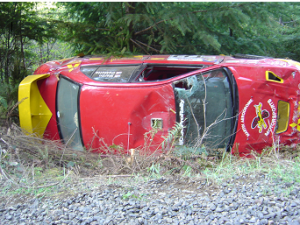 At Tim O’Neil’s Rally School and Car Control Center in the White Mountains of New Hampshire, students learn how to avoid “committing to the crash.” Important for the survival of rally car drivers. But in a very real and damaging way, we’re all committing to the crash in myriad ways every day.
At Tim O’Neil’s Rally School and Car Control Center in the White Mountains of New Hampshire, students learn how to avoid “committing to the crash.” Important for the survival of rally car drivers. But in a very real and damaging way, we’re all committing to the crash in myriad ways every day.
Committing to the crash means fixating on a ditch, rock, or tree looming menacingly in your path when (and it’s never if—it’s always when) your rally car lurches suddenly out of control and heads off the road. It’s absolutely amazing how just that thought will put your car and that tree together. It’s practically automatic.
Before a new student is turned loose on Tim’s private forest racing roads, he is subject to innumerable drifts around the skid pad, object avoidance exercises and high-speed car control techniques. Little by little, the novice begins to react automatically. Car starts oversteering? Countersteer and apply throttle. Understeering? Quick rip of the emergency brake to bring the back end around.
Then it’s off to the stage roads for the new drivers, real one-lane gravel roads with real trees zipping by inches from the door. Inevitably, the new driver will start to lose control of the car and will do what he’s always done—probably stand on the brake—instead of what he’s learned the last few days. And that tree on the outside of the corner? Well, it ends up denting his driver-side door.
What these new students haven’t done yet is let go of that commitment to the crash. Every fiber of their Knower/Judger beings knows that a car sliding sideways toward that tree is going to hit that tree. But Tim’s instructors know that tree can be routinely avoided. They teach the drivers to look down the road, past the obstacle, to see farther than the tree, to where they want to go. They teach them to let their skills take them through it. And it works.
Are you committing to the crash?
When you approach a difficult conversation with a boss, police officer, cold call, direct report, or spouse, do you commit to the crash? Does your K/J kick in and predict the outcome—which always comes true?
Here’s a secret. You already have the skills to avoid the crash. If you could figuratively look down the road past the obstacle and not make assumptions about how this conversation is going to go, your survival rate will skyrocket.
When you approach someone in your K/J, wearing your rules on your sleeve and assuming the outcome, the other person will respond from the K/J, defending their emotional turf. CRASH!
Approaching from your Learner/Researcher, with no preconceived notion of how this conversation will go, your chances of exploring data and getting clear with the other party are greatly enhanced. Tree avoided!
How do I get there when I just know (in my K/J) this conversation is going to be a problem? How do I look past the tree and down the road? Practice. Understand when you approach the conversation, what your K/J is telling you. Pull the plug on the automatic approach.
Anger management techniques include a rubber band on a wrist…pull it away and let it slap back and sting you, then enter the conversation.
I prefer Ho’oponopono.
I love you. I’m sorry. Please forgive me. Thank you.
How can you fear a tree you’ve just said that to? I have clients who’ve completely changed their success rates with once-scary prospects just by using this technique…no more crashes!
Oh, and I highly recommend Tim O’Neil’s school. You will leave a safer and more confident driver. And the venue is beautiful.


Kim,
Great article. I can’t think of a simpler solution that’s as difficult to implement. Send this to Boehner, Reid, and Obama.